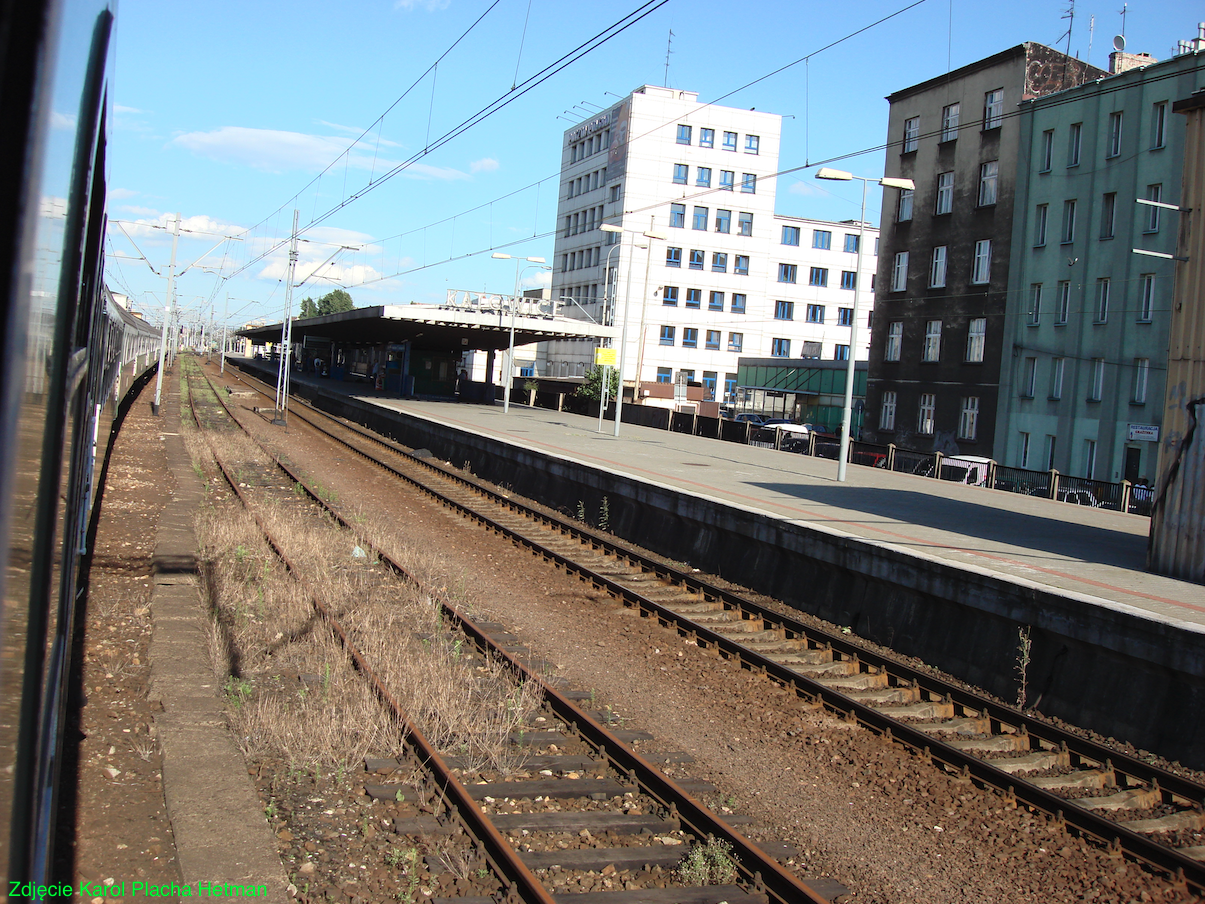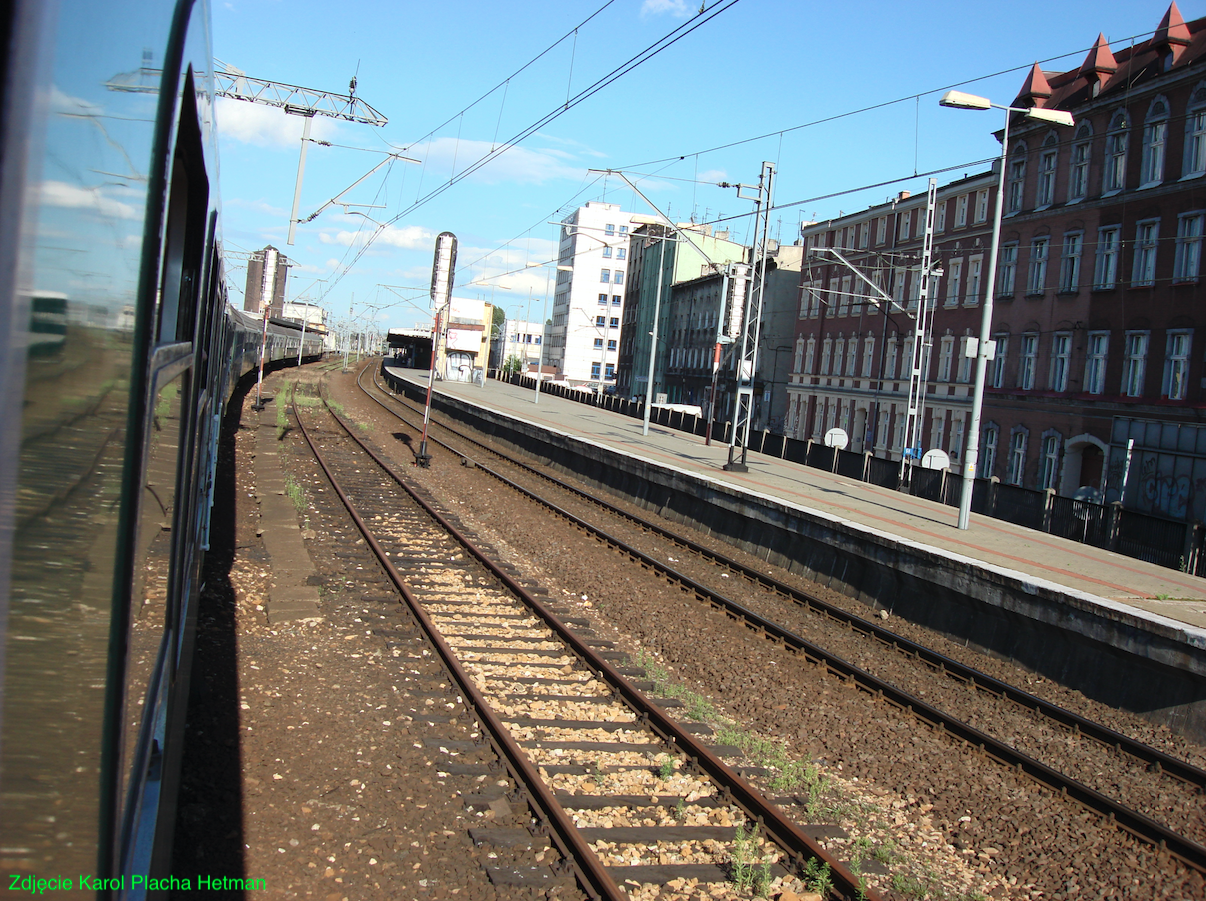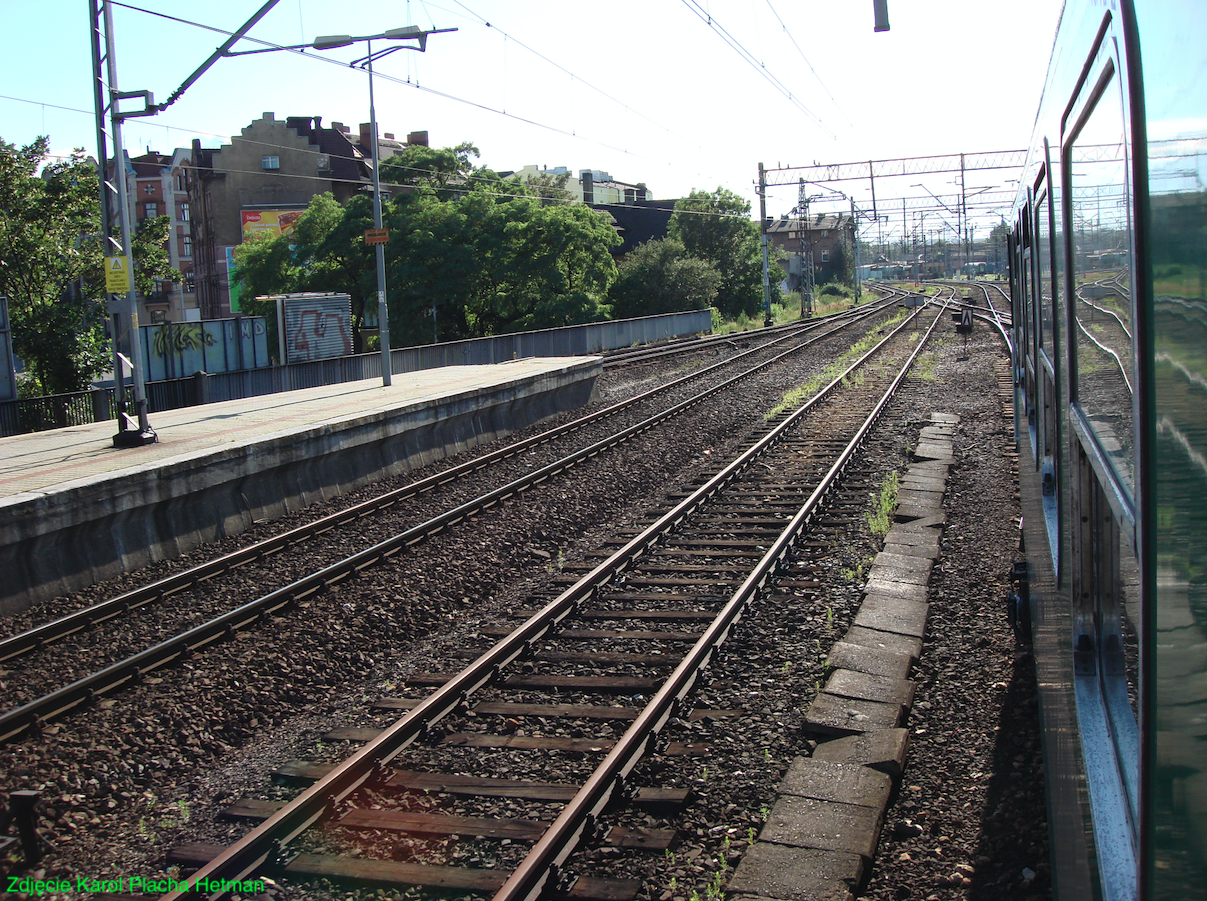Katowice 2007-03-15
Railway station in Katowice.
Geographic coordinates: 50.257N 19.017E.



Katowice is a city in Poland in the Silesian Voivodeship. Historically, it is Upper Silesia. The area of Katowice is 164.64 square kilometers. Elevation 245 - 357 m above sea level. The population is 282,755 inhabitants (2021). Katowice is the largest city in the Upper Silesian Industrial District, but not the oldest. Although Katowice in terms of the number of inhabitants is the 11th city in the Republic of Poland, next to Warsaw, Krakow, Poznań and Gdańsk, they are mentioned in the same breath. The name Katowice is genetically Slavic and Old Polish. From Katowice distance to: Częstochowa - 68 km. Krakow - 78 km. Wroclaw - 181 km. Warsaw - 291 km. Poznan - 309 km.
The settlement was founded in the 16th century as an agricultural, mining and metallurgical center. City rights were granted on September 11, 1865. The dynamic development of the city of Katowice took place when the railway line was built. More hard coal mines and steelworks were established. Heavy industry became the basis of the region's existence. Administratively, Katowice is located in the center of the so-called Industrial Upper Silesia.
In the period 1742 - 1922, Katowice was within the borders of Prussia. In the 19th century, Katowice and neighboring cities were multinational and multi-denominational, although with a clear predominance of Catholics. In 1887, waterworks were launched in Katowice. In 1922, Katowice was incorporated into Reborn Poland. The incorporation of part of Upper Silesia was associated with the Three Silesian Uprisings and plebiscites. As a result, Katowice together with the surrounding communes and part of Upper Silesia was annexed to Poland. Pursuant to the decree of October 3, 1922, Katowice became the seat of the authorities of the autonomous Silesian Voivodeship with its own Parliament (Silesian Parliament) and the Treasury (Skarb Śląski).
In the period 1939 - 1945, Katowice was under German occupation under the name of Kattowitz. The Germanic form Kattowitz is a simple phonetic adaptation of the Polish formant -ice as -itz, with the consonant doubling (here: root "t") required by German orthography after a short vowel ("a").
During the communist era, from March 9, 1953 to December 20, 1956, the city of Katowice bore the ugly name Stalinogród, which was introduced after the death of the Moscow dictator Joseph Stalin.
On June 20, 1983, Saint Pope John Paul II came to Katowice on a pilgrimage and met with the faithful at the airport in Muchowiec. About 1.5 million people came to the holy mass.
Katowice railway station.
The railway station in Katowice was opened on October 3, 1846 as a station on the Gliwice - Mysłowice route. Over the next years, the station turned into a junction station and the largest one in Upper Silesia. In 2018, the station served about 12 million passengers, i.e. about 32,880 people per day. In 2021, 30,400 people per day. The decrease in the number of travelers was due to the Chinese virus pandemic. The station has 5 platforms and 9 platform edges.
From the very beginning, the advantage of the Katowice station was and still is its location in the city center. The station has never been a leading station, which is why it gave the opportunity to travel in many directions. Both the Great World War and the Second World War did not cause any damage to the railway in the Katowice area, which was a plus for the station.
There were several proposals to run the first railway line through Silesia from Gliwice to the east. In 1837, the Joint Stock Company of the Upper Silesian Railway was founded. It was the shareholders of this company who decided about the course of the trail. The starting point - Gliwice and the ending point - Mysłowice were known. Mysłowice was located at the junction of three borders of the partitioning powers of Poland: Prussia, Austria-Hungary, and the Muscovite Empire. The Prussians sought to create a railway connection far to the east and to their brothers to Moscow. As a result of further activities, on April 5, 1841, the Upper Silesian Railway Society was established. The Wrocław-Mysłowice railway line was commissioned in stages, of which the Świętochłowice-Katowice-Mysłowice section was launched on October 3, 1846. The Upper Silesian Railway Society also took care of the construction of a route from Mysłowice to Kraków, which was then a Free City. When the station in Krakow was commissioned, Krakow was already included in the Austro-Hungarian partition.
Next railroads.
There was a lot of free land in the vicinity of the Katowice station, which was conducive to founding new production plants. On December 1, 1852, the Katowice - Ligota - Murcki railway line was built, about 12 km long, to the south. In Murcki there was the oldest hard coal mine in Upper Silesia.
As a result of talks between the Upper Silesian Railway and the Warsaw-Vienna Railway, it was decided to build a railway connection bypassing Jaworzno. Thanks to this, the Prussian partition gained a direct connection with the Kingdom of Poland (Moscow partition). On August 24, 1859, the route Ząbkowice - Dąbrowa Górnicza - Będzin - Sosnowiec - Szopienice was opened. The border between the invaders ran along the Czarna Przemsza River and the Brynica water canal. Muscovites built a customs post in the city of Sosnowiec. The Prussians set up a customs post at the Katowice station. The Katowice station was then expanded. A locomotive depot, a new water tower, and apartments for employees and their families were built.
Further railway connections to steelworks and mines were built; On December 1, 1859, the Katowice - Wełnowiec line was put into use, in the north direction, with a length of about 6 km. In 1864, another siding to the Katowice mine was opened, going east of the above line. In 1969, another siding was launched: Katowice - Huta Baildon.
From 1860, Katowice gained in importance, partly at the expense of Mysłowice station. 30% of hard coal, 70% of metallurgical products and 90% of agricultural products destined for Upper Silesia were transported through Katowice. The Katowice station became the second one in Silesia after Wrocław. This large traffic of goods and people caused Katowice to become a city, obtaining city rights in 1865.
In 1895, Katowice was the seat of the Directorate of the Prussian-Royal State Railways. The Katowice junction covered 1,279 km of tracks and employed 300 employees. During the day, 184 passenger and freight trains ran.
Katowice railway station. 1859.
The first station building was built in 1846. It was a small building made of half-timbered walls. The station served its function for several years, and then it was a warehouse. It was demolished at the end of the 19th century.
The new station building was built in 1859 as a large palace-like building. In fact, a complex of buildings was built along the railway tracks and Dworcowa Street. The address is 2 - 10 Dworcowa Street. The complex was entered into the register of monuments on December 18, 1975.
The station complex was built over several decades, along with the development of the station. The first major extension took place in the period 1906 - 1908, and then in 20 years, already in the times of the reborn Polish Republic. The complex from 1908 included the main hall with ticket offices, restaurants, offices, warehouses, rooms for railway services, flats for railway employees. A second passenger service hall was added. These are the buildings that have rosettes in the front walls. The central part of the complex was built in the modernist style and had one floor and two avant-corps with two floors. In 1925, more floors were added, both in the middle element and in projections. Thus, a large office building was created. Among others, the District Court was located here (in the interwar period). The station complex served its function until 1972.
The complex of station buildings required renovation, while maintaining the style in which it was built. In 2007, the complex was sold for PLN 45 million to a private company. But the company collapsed and the complex was auctioned off by a bailiff for the company's debts in 2015. Another private company became the owner. In 2022, the reconstruction of the old station was completed - the building at 8 Dworcowa Street. The building serves as an office. The facade of the building has undergone a major change, and the interior even more. The building is owned by Opal and the tenant is Cluster.
1922 - 1939.
The Katowice station played a very important role. From it, trains with "Polish Gold" (hard coal) were dispatched to the interior of Poland and for export to Gdynia. Metallurgical products were sent and agricultural products were brought; mainly potatoes and corn. At that time, the station had 7 platforms. The platforms were covered. A tunnel for travelers was built along Mielęckiego and Podgórna streets. The tunnel is still in use. Inside, there are murals on the walls.
1939 - 1945.
During the German occupation, the Katowice station did not suffer. All of Upper Silesia worked for the Germans for the needs of their war. In 1945, the retreating Germans blew up the brick water tower, which was rebuilt in 1951. The tower is still standing (2023).
After World War II.
There were seven platforms at the station. Access to Platform 6 and Platform 7 was from the level of Wojewódzka Street. A tunnel led to the other platforms. But only one platform could receive long passenger trains.
In the 1950s, the electrification of railways in Upper Silesia began. The initial goal was to electrify the route Katowice - Warsaw. On June 1, 1957, the route Gliwice - Katowice - Sosnowiec Główny was electrified. The entire route to Warsaw was electrified by 1958. As a result, the fastest EMU train covered the distance Katowice - Warsaw in 3 hours 27 minutes. The commercial speed was 92.2 km/h.
Katowice railway station. 1972.
After World War II, the station turned out to be too small. The main hall of the station could hold only 1,500 passengers. The tunnel under the tracks and platforms was narrow. Building a separate westbound freight station didn't help much. A new locomotive depot with a rectangular hall was built there.
The plan to build a new station was drawn up in 1955. But there were many problems to solve. Firstly, it was impossible to liquidate the old station. Secondly, there were attempts to redirect heavy freight traffic to the Katowice Muchowiec station, which was only partially successful. There were several proposals, including the construction of a new station in the place where the Katowice Załęże passenger stop is now located. However, it was the most expensive solution, because apart from the station, the entire road system would have to be built. Let us remember that the socialist economy was badly managed by the communists. Therefore, it was decided to build a new station only 500 m further to the west. For the new station, it was decided to demolish tenement houses at the streets: Sądowa, Młyńska, 3 Maja.
In 1958, two new platforms were put into operation; then No. 11 and 12, and then renamed Platform 1 and Platform 2. In 1964, a station pavilion was built on the south side. In 1968, two more platforms were opened; Platform 3 (13), Platform 4 (14). Waiting rooms, toilets, ticket offices and retail outlets have been set up. As you can see, the work proceeded very slowly. In December 1970, Edward Gierek, a former miner, became the leader of the Communist Party of the Polish United Workers' Party. This fact accelerated the investment and in 1972, the new station was ready.
The new station stood out among the stations in Poland. It was modern, spacious and bright. It was two-level. In addition, it was the first transfer center in Poland. The roof of the station was supported by 16 cup-type pillars. The station was 140 m long and 53 m wide. The volume of the facility was 76,314 m3. At the same time, 25,000 travelers could stay in the building. Three tunnels led from the station to the platforms. The western one opened in 1964. The eastern and middle tunnels were opened much later. In addition to the usual stairs, the building used escalators, which was a modern solution at the time. Both floors of the station were connected in several places inside. On the lower floor there were: cash registers, a restaurant, a bar, toilets, a lost property office, and a left-luggage office. On the second floor were; cash desks, cafe, ticket offices, post office, railway information, "RUCH" kiosks, office rooms. There are benches for travelers in many places. The interior was additionally illuminated by lamps equipped with fluorescent lamps. There were numerous neon signs, railway information boards, directional boards, railway information audio system, numerous clocks, flowers in pots. The floor is made of granite slabs.
From the upper level of the station, there was an overpass heading north to 3 Maja Street. Thanks to it, travelers could walk to the bus station or to public transport; trams and buses. There was an international bus station under the flyover, which was also accessible from the flyover.
For many decades, the station fulfilled its role well, serving millions of passengers every year. The station was the representative place of the city. It is worth mentioning that the station in Katowice was the work of the best Polish architects: Wacław Kłyszewski, Jerzy Mokrzyński and Eugeniusz Wierzbicki. They were called "Tigers" because in the 60s/70s they won many competitions. The design of the structure itself was prepared by Wacław Zalewski, considered one of the most innovative and influential constructors of the time.
Written by Karol Placha Hetman
